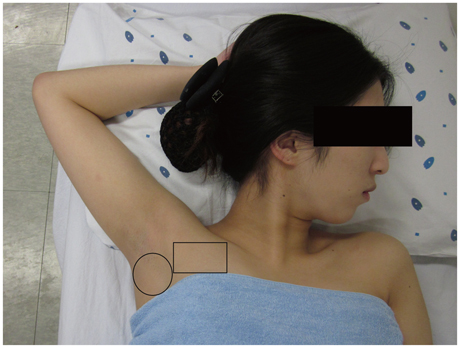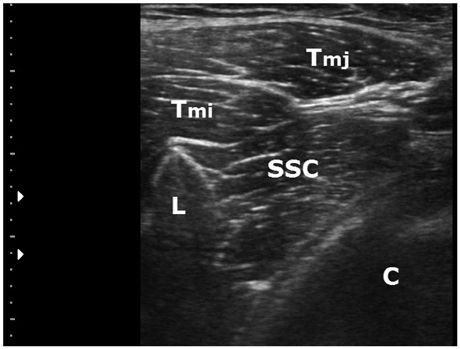Yonsei Med J.
2014 May;55(3):792-799. 10.3349/ymj.2014.55.3.792.
Application of Ultrasound-Guided Trigger Point Injection for Myofascial Trigger Points in the Subscapularis and Pectoralis Muscles to Post-Mastectomy Patients: A Pilot Study
- Affiliations
-
- 1Department of General Surgery, Myongji Hospital, Kwandong University College of Medicine, Goyang, Korea.
- 2Department and Research Institute of Rehabilitation Medicine, Yonsei University College of Medicine, Seoul, Korea. bettertomo@yuhs.ac
- 3Department of Physical and Rehabilitation Medicine, Samsung Medical Center, Sungkyunkwan University School of Medicine, Seoul, Korea.
- KMID: 2068693
- DOI: http://doi.org/10.3349/ymj.2014.55.3.792
Abstract
- PURPOSE
To investigate the therapeutic effectiveness of ultrasound (US)-guided trigger point injection for myofascial trigger points (MTrPs) in the internal rotator muscles of the shoulder in post-mastectomy patients.
MATERIALS AND METHODS
This pilot study was a non-controlled, prospective, clinical trial. Nineteen post-mastectomy patients with a diagnosis of at least one active MTrP in the subscapularis and/or pectoralis muscles were included. We performed trigger point injections into the subscapularis muscle deep behind the scapula as well as the pectoralis muscle for diagnostic and therapeutic purpose by the newly developed US-guided method.
RESULTS
Visual analogue scale and range of motion of the shoulder for external rotation and of abduction showed significant improvement immediately after the first injection and 3 months after the last injection compared with baseline (p<0.05 for both). Duration from onset to surgery and duration of myofascial pain syndrome in the good responder group were significantly shorter than in the bad responder group (p<0.05). Patients did not report any complications related to the procedure or serious adverse events attributable to the treatment.
CONCLUSION
In post-mastectomy patients with shoulder pain, US-guided trigger point injections of the subscapularis and/or pectoralis muscles are effective for both diagnosis and treatment when the cause of shoulder pain is suspected to originate from active MTrPs in these muscles, particularly, the subscapularis.
MeSH Terms
-
Adult
Aged
Anesthetics, Local/administration & dosage/therapeutic use
Female
Humans
Injections, Intramuscular/methods
Lidocaine/administration & dosage/therapeutic use
Mastectomy
Middle Aged
Muscle, Skeletal/drug effects/ultrasonography
Myofascial Pain Syndromes/drug therapy
Pectoralis Muscles/drug effects/*ultrasonography
Trigger Points/*ultrasonography
Anesthetics, Local
Lidocaine
Figure
Cited by 2 articles
-
Comparison between Steroid Injection and Stretching Exercise on the Scalene of Patients with Upper Extremity Paresthesia: Randomized Cross-Over Study
Yong Wook Kim, Seo Yeon Yoon, Yongbum Park, Won Hyuk Chang, Sang Chul Lee
Yonsei Med J. 2016;57(2):490-495. doi: 10.3349/ymj.2016.57.2.490.Ultrasound-Guided Trigger Point Injection for Myofascial Trigger Points in the Subscapularis and Pectoralis Muscles
Lokesh Gupta, Shri Prakash Singh
Yonsei Med J. 2016;57(2):538-538. doi: 10.3349/ymj.2016.57.2.538.
Reference
-
1. Lee SA, Kang JY, Kim YD, An AR, Kim SW, Kim YS, et al. Effects of a scapula-oriented shoulder exercise programme on upper limb dysfunction in breast cancer survivors: a randomized controlled pilot trial. Clin Rehabil. 2010; 24:600–613.
Article2. Ebaugh D, Spinelli B, Schmitz KH. Shoulder impairments and their association with symptomatic rotator cuff disease in breast cancer survivors. Med Hypotheses. 2011; 77:481–487.
Article3. Cheville AL, Tchou J. Barriers to rehabilitation following surgery for primary breast cancer. J Surg Oncol. 2007; 95:409–418.
Article4. Stubblefield MD, Custodio CM. Upper-extremity pain disorders in breast cancer. Arch Phys Med Rehabil. 2006; 87:3 Suppl 1. S96–S99.
Article5. Torres Lacomba M, Mayoral del Moral O, Coperias Zazo JL, Gerwin RD, Goñí AZ. Incidence of myofascial pain syndrome in breast cancer surgery: a prospective study. Clin J Pain. 2010; 26:320–325.
Article6. Simons DG. Review of enigmatic MTrPs as a common cause of enigmatic musculoskeletal pain and dysfunction. J Electromyogr Kinesiol. 2004; 14:95–107.
Article7. Fernández-Lao C, Cantarero-Villanueva I, Fernández-de-Las-Peñas C, Del-Moral-Ávila R, Menjón-Beltrán S, Arroyo-Morales M. Development of active myofascial trigger points in neck and shoulder musculature is similar after lumpectomy or mastectomy surgery for breast cancer. J Bodyw Mov Ther. 2012; 16:183–190.
Article8. Rha DW, Han SH, Kim HJ, Won SY, Lee SC. Ultrasound-guided lateral approach for needle insertion into the subscapularis for treatment of spasticity. Arch Phys Med Rehabil. 2012; 93:1147–1152.
Article9. Muscolino JE. The muscle and bone palpation manual with trigger points, referral patterns, and stretching. 1st ed. St. Louis (Mo): Mosby Inc;2009.10. Simons DG. Muscle pain syndromes--Part I. Am J Phys Med. 1975; 54:289–311.11. Rha DW, Shin JC, Kim YK, Jung JH, Kim YU, Lee SC. Detecting local twitch responses of myofascial trigger points in the lower-back muscles using ultrasonography. Arch Phys Med Rehabil. 2011; 92:1576–1580.
Article12. Hamada H, Moriwaki K, Shiroyama K, Tanaka H, Kawamoto M, Yuge O. Myofascial pain in patients with postthoracotomy pain syndrome. Reg Anesth Pain Med. 2000; 25:302–305.
Article13. Cheville AL, Troxel AB, Basford JR, Kornblith AB. Prevalence and treatment patterns of physical impairments in patients with metastatic breast cancer. J Clin Oncol. 2008; 26:2621–2629.
Article14. Cummings M. Myofascial pain from pectoralis major following trans-axillary surgery. Acupunct Med. 2003; 21:105–107.
Article15. Lee TS, Kilbreath SL, Refshauge KM, Herbert RD, Beith JM. Prognosis of the upper limb following surgery and radiation for breast cancer. Breast Cancer Res Treat. 2008; 110:19–37.
Article16. Levangie PK, Drouin J. Magnitude of late effects of breast cancer treatments on shoulder function: a systematic review. Breast Cancer Res Treat. 2009; 116:1–15.
Article17. Gyedu A, Kepenekci I, Alic B, Akyar S. Evaluation of muscle atrophy after axillary lymph node dissection. Acta Chir Belg. 2009; 109:209–215.
Article18. Kim SM, Park JM. Normal and abnormal US findings at the mastectomy site. Radiographics. 2004; 24:357–365.
Article19. Katz J, Poleshuck EL, Andrus CH, Hogan LA, Jung BF, Kulick DI, et al. Risk factors for acute pain and its persistence following breast cancer surgery. Pain. 2005; 119:16–25.
Article20. Harrison TP, Sadnicka A, Eastwood DM. Motor points for the neuromuscular blockade of the subscapularis muscle. Arch Phys Med Rehabil. 2007; 88:295–297.
Article21. Yelnik AP, Colle FM, Bonan IV. Treatment of pain and limited movement of the shoulder in hemiplegic patients with botulinum toxin a in the subscapular muscle. Eur Neurol. 2003; 50:91–93.
Article22. Salisbury SK, Choy NL, Nitz J. Shoulder pain, range of motion, and functional motor skills after acute tetraplegia. Arch Phys Med Rehabil. 2003; 84:1480–1485.
Article23. Ingber RS. Shoulder impingement in tennis/racquetball players treated with subscapularis myofascial treatments. Arch Phys Med Rehabil. 2000; 81:679–682.
Article24. Chou LW, Hsieh YL, Chen HS, Hong CZ, Kao MJ, Han TI. Remote therapeutic effectiveness of acupuncture in treating myofascial trigger point of the upper trapezius muscle. Am J Phys Med Rehabil. 2011; 90:1036–1049.
Article25. Hong CZ. Pathophysiology of myofascial trigger point. J Formos Med Assoc. 1996; 95:93–104.26. Hong CZ, Simons DG. Pathophysiologic and electrophysiologic mechanisms of myofascial trigger points. Arch Phys Med Rehabil. 1998; 79:863–872.
Article
- Full Text Links
- Actions
-
Cited
- CITED
-
- Close
- Share
- Similar articles
-
- Ultrasound-Guided Trigger Point Injection for Myofascial Trigger Points in the Subscapularis and Pectoralis Muscles
- Trigger Point Injection for the Treatment of Myofascial Pain Syndrome
- Treatment Experience of Pulsed Radiofrequency Under Ultrasound Guided to the Trapezius Muscle at Myofascial Pain Syndrome: A Case Report
- Changes in the Pressure Threshold of Myofascial Trigger Points Following Freezing Cold Air Application
- Ischemic Compression After Trigger Point Injection Affect the Treatment of Myofascial Trigger Points





